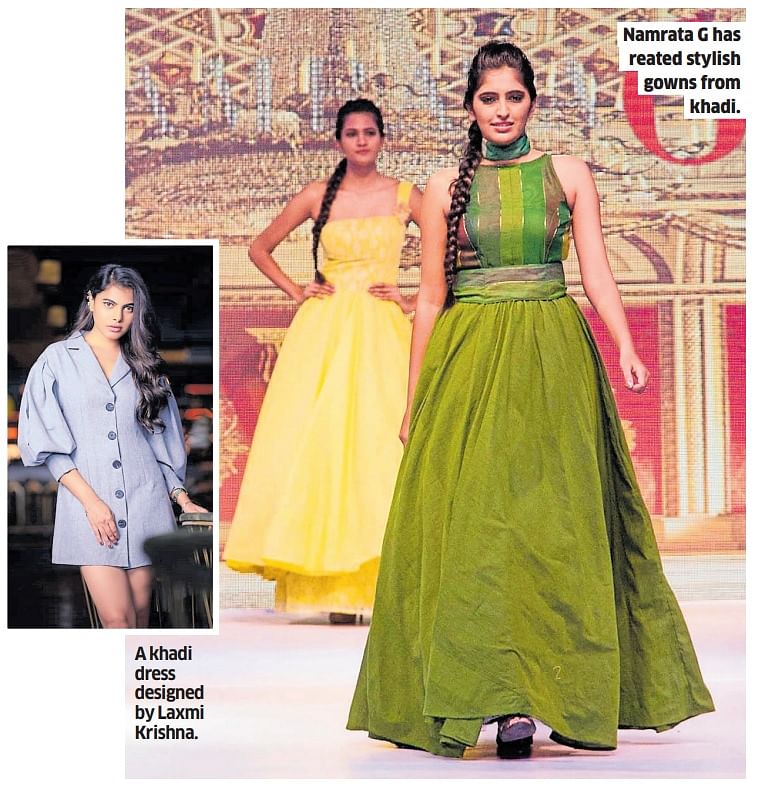
Khadi, a weave popularised by Mahatma Gandhi during the pre-Independence era, has undergone a lot of changes over the years. On Gandhi’s 152nd birth anniversary, khadi enthusiasts throw light on the humble fabric’s transformation.
Khadi was launched in 1920, as a form of protest against the British by Gandhi. It soon became the favoured garment of politicians in the country, and today it has grown to be much more than that.
City-based designer Namrata G, says working with khadi is challenging. “After designers like me pick up a roll to work with, if we go back for more, it is often not available. Real khadi is woven on the charkha and there are restrictions on how much can be made, consistency and how often it can be delivered,” she says.
Khadi by itself is often plain, but to make it trendy, a lot of styling and work goes in.
Namrata has worked on a range of Western wear in khadi with a focus on gowns. Her newest brand ‘Artham’, is about anything sustainable. “We invited all our clients to bring their saris and are recreating them into something else. Of this lot, khadi saris are being turned into pants, layered tops and dresses,” she says.
She wants everyone to wear khadi and be proud to wear it. “The fabric is attached to our heritage. I hope that khadi becomes a global fabric soon.”
Namrata adds that the government has put in lots of efforts to promote the fabric and new styles and designs are coming up. “They have also taken some shows out of the country, which has helped.”
In upcoming innovations, Namrata is looking at creating accessories and footwear out of the fabric.
‘Rich look’
From Indo-Western to face masks, Shiny Alexander has created much with khadi.
“Our masks are mainly made of khadi. We’ve worked with casual and daily wear to semi-formal looks in khadi,” she says.
Shiny had worked on two cords, cigarette pants with kurtas and dresses with the fabric. Neutral shades like beiges, browns, blues and multiple shades of greys dominate her collection. “Handlooms have a rich look to it and there is a lot of history behind it.”
People above 30 and working women are her clientele. “People who understand the value of the fabric and take care of it well are usually those who opt for it,” she says.
City-based designer Sanjay Choraria, co-owner of Chola Fashions, believes it’s time khadi loses the “humble garment” tag. “The weavers put so much effort into the making of the cloth, that in reality it should be considered a luxury rather than a humble piece of cloth. The weavers need to be rightfully paid for their hard work,” he says.
In recent years, Sanjay and his wife Shammy, have worked on creating trendy khadi garments for both men and women. “We have created everything from simple kurtas to wedding sherwanis and blazers from khadi and our customers have loved it, especially millennials,” he adds.
The duo has played around with khadi to make it fit better with the aesthetics of the current generation.
“Initially customers used to shy away from khadi as they believed it was a stiff fabric, but we showed them that it is not the case. Today we have khadi that’s been treated and is very soft and flowy in nature. It lends itself very well to gowns and feminine silhouettes, especially with all the vibrant colours khadi is available in today,” says Shammy.
‘More than fast fashion’
Laxmi Krishna, another designer from Bengaluru also feels that the availability of khadi in lively colours has encouraged more designers to experiment with it. “Today, you get khadi in both pastel and bright colours. This has changed the game. Many clients prefer khadi now, even for their western outfits. Recently I created a lot of modern dresses. Khadi gives a sophisticated look to western outfits that many women especially are drawn to,” she elaborates.
As a designer in the Kannada film industry, she is currently working on a biopic project based in 1950. “I’ve created an entire wardrobe of clothes with khadi to go with the theme,” she says.
Even off-screen, many actors take a liking to khadi garments, says Laxmi. “Apart from aesthetics, sustainability is also one of the reasons many prefer khadi today,” she adds.
“Khadi can be worn for much longer compared to other fast fashion items. It is extremely eco-friendly and sustainable. I believe it’ll become more popular with the current generation who are much more aware of climate change,” adds Sanjay.